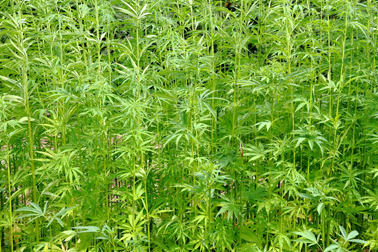
By TreeLiving
There are lots of plants that we can’t live without. There are others we might never have heard of that could be the salvation plants of the future. Kenaf could be one of those plants, thanks to its multiple capabilities and green potential. Agricultural scientists are looking for crops that are relevant to environmental problems and suitable for creating eco solutions. Kenaf is a plant that fits the bill in several ways.
Kenaf, or Hibiscus cannabinus, is a member of the mallow family and of uncertain origins. It may be native to either Africa or Asia. Though originally a tropical plant, it is now cultivated in warmer climates around the world because of its remarkable multiple uses, amazingly fast growth habit and ease of cultivation.
Kenaf produces protein-rich, edible leaves and yields a vegetable oil for cosmetics, industry and biofuels. It grows prolifically – up to 18 feet in only six months or so. This means that kenaf growing can yield large quantities of fiber, from both the bark and the core. This is valuable for making paper pulp, rope, animal bedding, and construction materials, amongst other products.
That’s impressive enough, but it’s the plant’s potential to capture excess carbon dioxide (CO2), that has really made environmental waves. Carbon dioxide is one of the biggest culprit gases implicated in global warming. Kenaf seems to have the ability to capture and permanently store it, in large quantities: double or more the amount stored by a tree in one of the world’s ‘green lung’ forests.
An acre of well-managed kenaf can suck 10 or 20 tons of CO2 out of the atmosphere in a single growing season. It provides animal and human food as well as other by-products. It grows like mad. It doesn’t require heavy watering, heavy use of pesticides or fertilizing. Because the stems are low in lignin, kenaf paper is easier and cheaper to produce than other conventionally used materials. It all seems like an eco dream come true.
One of the problems is storing (or ‘sequestering’) the carbon on a permanent basis. One solution to this is to use the inner core of the kenaf as an aggregate in lightweight cement building blocks – saving on other materials and on the cost of transporting the finished green building material. These building blocks are being experimentally produced in pilot projects, apparently with some success since the costing was fine-tuned.
Another concern is that the plant will spread like wildfire. Proponents argue that this cannot happen in the US because the seeds need particular frost-free conditions to germinate. But what about other countries that might want to cash in? The ramifications of intensive cultivation of kenaf are still unclear.
Though there are still issues to be resolved, the use of kenaf as a natural means for capturing excess environmental carbon dioxide is exciting, at least in principle. If it can deliver everything its proponents promise, then it may be a small but key step to addressing pressing environmental problems.

